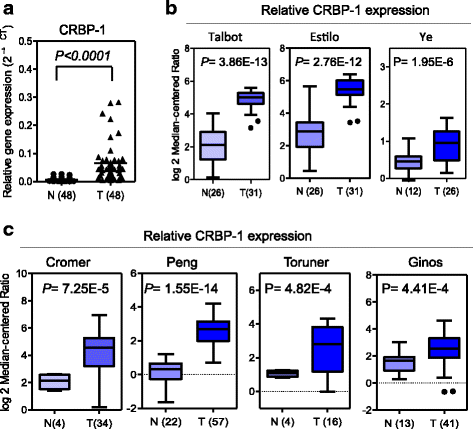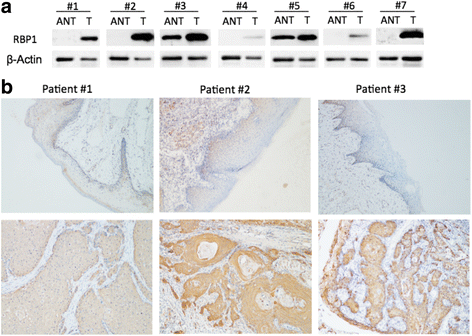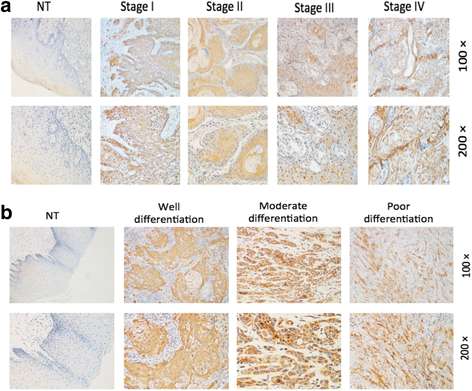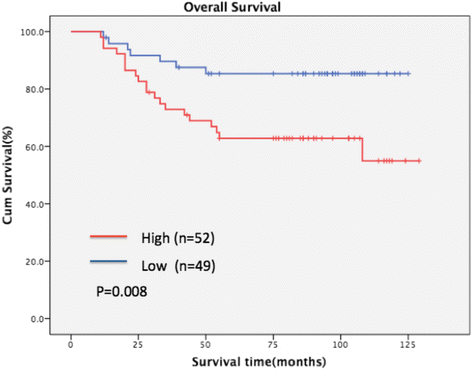CRBP-1 over-expression is associated with poor prognosis in tongue squamous cell carcinoma
- PMID: 29720147
- PMCID: PMC5932876
- DOI: 10.1186/s12885-018-4249-1
CRBP-1 over-expression is associated with poor prognosis in tongue squamous cell carcinoma
Abstract
Background: Tongue squamous cell carcinoma (TSCC) is one of the most common malignancies of oral squamous cell carcinomas. Cellular retinol binding protein-1 (CRBP-1) as a carrier protein transports retinol from the liver storage site to peripheral tissue. Up-regulated expression of CRBP-1 is associated with some tumor types such as prostate cancer, breast cancer and ovarian cancer as reported, but its role in TSCC remains uncertain.
Methods: In this study, an integrated bioinformatics analysis based on the multiple cancer microarray data sets available from Oncomine database was conducted to view the differential expression of CRBP-1 between TSCC and the adjacent non-tumorous tissues. Quantitative real-time polymerase chain reaction (qRT-PCR), western blotting (WB) and immunohistochemical (IHC) assays were performed to investigate CRBP-1 expression in 101 paraffin-embeded TSCC tissues and 48 pairs of freshly frozen tissues. Kaplan-Meier curve and univariate and multivariate Cox-regression analysis were used to estimate the association between CRBP-1 expression and patients' prognosis. Then western blotting, MTT, transwell migration and invasion assays were performed in TSCC cell lines to investigate the effects of CRBP-1 on cellular proliferation and invasion.
Results: Compared with the matched adjacent non-tumorous tissues, the expression of CRBP-1 was significantly up-regulated in TSCC tissues, which correlated with the differentiation state (P = 0.003), N classification (P = 0.048), the clinical stage (P = 0.048) and death (P = 0.001). The Kaplan-Meier curve showed that TSCC patients with higher CRBP-1 expression levels had lower overall survival rates than those with lower CRBP-1 expression levels. A univariate and multivariate analysis demonstrated that CRBP-1 was an independent prognostic factor (P < 0.05). Furthermore, we knocked down CRBP-1 expression and observed that TSCC cell proliferation and invasion in vitro were significantly blocked, as determined by MTT and transwell assays.
Conclusions: Up-regulated expression of CRBP-1 is associated with poor prognosis in TSCC, so it might potentially serve as an additional prognostic marker, and the inhibition of CRBP-1 might provide new therapeutic approaches for TSCC.
Keywords: CRBP-1; Expression; Invasion; Knockdown; Prognosis; Proliferation; Tongue squamous cell carcinoma.
Conflict of interest statement
Ethics approval and consent to participate
The Ethics Committee of the Sun Yat-sen University Cancer Center approved all the tumor specimens used for this study. All the participating patients in this study have signed the informed consent forms.
Consent for publication
Not applicable.
Competing interests
The authors declare that they have no competing interests.
Publisher’s Note
Springer Nature remains neutral with regard to jurisdictional claims in published maps and institutional affiliations.
Figures





Similar articles
-
Overexpression of HMGA2 promotes tongue cancer metastasis through EMT pathway.J Transl Med. 2016 Jan 27;14:26. doi: 10.1186/s12967-016-0777-0. J Transl Med. 2016. PMID: 26818837 Free PMC article.
-
LncRNA MALAT1 expression inhibition suppresses tongue squamous cell carcinoma proliferation, migration and invasion by inactivating PI3K/Akt pathway and downregulating MMP-9 expression.Eur Rev Med Pharmacol Sci. 2019 Jan;23(1):198-206. doi: 10.26355/eurrev_201901_16765. Eur Rev Med Pharmacol Sci. 2019. PMID: 30657561
-
EphA8 is a Prognostic Factor for Oral Tongue Squamous Cell Carcinoma.Med Sci Monit. 2018 Oct 9;24:7213-7222. doi: 10.12659/MSM.910909. Med Sci Monit. 2018. PMID: 30300334 Free PMC article.
-
MicroRNAs in human tongue squamous cell carcinoma: From pathogenesis to therapeutic implications.Oral Oncol. 2017 Apr;67:124-130. doi: 10.1016/j.oraloncology.2017.02.015. Epub 2017 Feb 27. Oral Oncol. 2017. PMID: 28351566 Review.
-
MicroRNA expression as a prognostic biomarker of tongue squamous cell carcinoma (TSCC): a systematic review and meta-analysis.BMC Oral Health. 2024 Mar 31;24(1):406. doi: 10.1186/s12903-024-04182-0. BMC Oral Health. 2024. PMID: 38556858 Free PMC article.
Cited by
-
Correlation of carbonic anhydrase 9 (CA9) with pathological T-stage and prognosis in patients with oral tongue squamous cell carcinoma.Ann Transl Med. 2020 Nov;8(22):1521. doi: 10.21037/atm-20-7144. Ann Transl Med. 2020. PMID: 33313266 Free PMC article.
-
Coronary artery disease-associated immune gene RBP1 and its pan-cancer analysis.Front Cardiovasc Med. 2023 Mar 9;10:1091950. doi: 10.3389/fcvm.2023.1091950. eCollection 2023. Front Cardiovasc Med. 2023. PMID: 36970364 Free PMC article.
-
Multi-marker analysis of genomic annotation on gastric cancer GWAS data from Chinese populations.Gastric Cancer. 2019 Jan;22(1):60-68. doi: 10.1007/s10120-018-0841-y. Epub 2018 Jun 1. Gastric Cancer. 2019. PMID: 29859005
-
Development of an Immunogenomic Landscape-Based Prognostic Index of Head and Neck Squamous Cell Carcinoma.Front Mol Biosci. 2020 Nov 24;7:586344. doi: 10.3389/fmolb.2020.586344. eCollection 2020. Front Mol Biosci. 2020. PMID: 33330624 Free PMC article.
-
Knockdown of ectodysplasin-A receptor-associated adaptor protein exerts a tumor-suppressive effect in tongue squamous cell carcinoma cells.Exp Ther Med. 2020 May;19(5):3337-3347. doi: 10.3892/etm.2020.8578. Epub 2020 Mar 6. Exp Ther Med. 2020. PMID: 32266031 Free PMC article.
References
-
- Adeel M, Suhail A. Squamous cell carcinoma of oral tongue in young patients – a 10 years tertiary care experience. J Pak Med Assoc. 2016;66:155–158. - PubMed
MeSH terms
Substances
Grants and funding
LinkOut - more resources
Full Text Sources
Other Literature Sources
Research Materials

